Overview
- Brief Narrative
- Floral handkerchief carried by 7 year old Judit Gondos when she left Budapest, Hungary, with her parents Bela and Anna on the Kasztner train in June 1944. It was a gift from her maternal aunt, Iren (Pircsi) Havas, in prewar Bekes. Jews were increasingly persecuted by the Nazi-influenced Hungarian regime. Bela worked on 2 or 3 forced labor battalions until released in 1942, because he was a physician. On March 19, 1944, Germany invaded Hungary and the authorities prepared to deport all the Jews from Hungary to concentration camps. In mid-May, Bela heard about the Kasztner train, negotiated by Rezso Kasztner of the Relief and Rescue Committee, Hungarian Zionist Association, to get the German SS to take money to release Jews to neutral territory. Bela and his family were selected because of Bela’s Zionist ties. Kasztner failed to raise sufficient funds and the train was sent to Bergen-Belsen, arriving on July 8. After ransom money was raised by Jewish aid organizations, the prisoners were sent to Switzerland on December 7, 1944. Judit’s aunt Pircsi survived Auschwitz and Bergen-Belsen but died of tuberculosis in Sweden in 1945. Bela, Anna, and Judit emigrated to the United States in 1946.
- Date
-
received:
approximately 1942
use: approximately 1942-1946
- Geography
-
received:
Bekes (Hungary)
use: Budapest (Hungary)
use: Bergen-Belsen (Concentration camp); Belsen (Bergen, Celle, Germany)
- Credit Line
- United States Holocaust Memorial Museum Collection, Gift of Judith Gondos Jacobs
- Contributor
-
Subject:
Judith G. Jacobs
Subject: Iren Havas
Artisan: Iren Havas
- Biography
-
Judit Gondos was born on April 27, 1937, in Budapest, Hungary, the only child of a Jewish couple, Bela and Anna Ilona Havas Gondos. Bela was born on November 25, 1903, in Erdobenye, Hungary, to an Orthodox Jewish family. He was an active Zionist and worked as a radiologist. Anna was born on June 22, 1910, in Gurahont, Romania, to an assimilated Jewish family. She was as an artist and interior designer. Bela and Anna married in 1934. They had a prosperous life with several maids and lived in a large apartment. Anna and Judit spent the summers visiting Anna’s family in Bekes.
Hungary was governed by a fascist regime, allied with Nazi Germany, with antisemitic laws modeled on the Nuremberg Laws. From 1939, Jewish men were forced into the Hungarian labor service, which was put under army command in 1940. In spring 1941, Hungary joined the German invasions of Yugoslavia and the Soviet Union. Bela was conscripted into forced labor two to three times. While he was gone, the family had no income. Judit's mother Anna made leather goods to sell. They had to let go of their help and experienced food shortages. There were constant air raids and Judit and Anna had to go to a Jews only, less secure bomb shelter in the basement. Bela was released from the labor service in 1942 because he was a physician. In September 1943, Judit began first grade at a Jewish day school. On March 19, 1944, Germany occupied Hungary. Anti-Semitic restrictions were implemented immediately. On March 31, Star of David badges were required for Jews older than six. The medical clinic where Bela worked was closed. Judit was no longer allowed to attend school. They had to turn over their valuables. They could leave their apartment for only 2 hours a day, but it was dangerous because the Gestapo would pick up Jews on the street. Bela left home to get news from the Jewish community center daily, although Anna did not want him to go. In April 1944, their apartment building was designated a yellow star Jewish house and several relatives came to live with them.
In mid-May, Bela was informed about a rescue train to Spain or Portugal that was being organized by a Zionist organization, the Relief and Rescue Committee. Because of Bela’s participation in the Zionist movement, the Committee selected Bela and his family to leave on the Kasztner rescue train. The transport was a plan negotiated by Rezso Kasztner of the Relief and Rescue Committee of the Hungarian Zionist Association in Budapest to get the German SS to allow a train of Jews to leave the country in exchange for money. Judit and her family reported to assembly camp in mid-June and waited for several days. Judit’s paternal uncle Sandor had been conscripted into forced labor, but his wife, Margalit Koves Gondos, and their daughter, Nomi, also went on the transport. They each carried a suitcase with them and Judit carried her doll. On June 30, the train left Budapest with 1686 passengers. They traveled on a cattle car with no sanitary facilities and were not given any food or water. Kasztner was not able to raise sufficient funds, so the transport was sent to Bergen-Belsen concentration camp in Germany. They went to Bratislava, Czechoslovakia, then stopped briefly in Linz, Austria. There was an air raid and the German guards made them stand exposed on the train platform until it was over.
On July 8, they arrived in Bergen-Belsen, after walking several miles from the train to the camp. They were housed separately from the other inmates in the Hungarian camp and did not work. Judit stayed with her mother in the female barracks while Bela stayed in the male barracks. They were not physically harmed by the guards but were verbally abused. They wore their own clothing, but had to display a Jewish badge. The prisoners were permitted to have religious services and observed the High Holidays. They had to stand outside every morning for hours for roll call. Their rations were meager and Bela and Anna both gave some of their portions to Judit. As the weather grew colder, Judit outgrew her clothing and shoes. On December 7, the prisoners were taken from the camp and walked to the train station. They boarded a heated passenger train with sanitary facilities and were sent to a collection center in St. Gallen, Switzerland. Jewish aid organizations had raised enough money to ransom the prisoners. After a few days, they were taken to Caux sur Montreux and lived in a resort hotel. The war ended when Germany surrendered on May 7, 1945.
Judit and her parents learned that their entire family had perished in the Holocaust, except for Bela’s brother Zoltan, who had emigrated to the United States before the war. Although they had planned to go to Palestine, Bela and Anna decided to emigrate to the United States to be near Zoltan. Judit was sent to boarding school near Fribourg, which was very difficult for her. Bela and Anna moved to Zurich, where Bela worked as a volunteer radiologist at the university while Anna cleaned vegetables and peeled potatoes at the Canton hospital to support the family. In summer 1946, the family moved to the Home for Intellectuals in Geneva, where Judit was tutored in English and math. On October 21, they sailed from Genoa on the SS Matthew O’Brien, arriving in Gulfport, Mississippi, in November. They joined Bela’s brother Zoltan in Falls Church, Virginia. Bela, who had obtained US medical certification, resumed his medical career. They learned that Bela’s brother Sandor had survived the Hungarian Labor Service and emigrated to Palestine in 1947 with his wife, Margalit, and daughter, Nomi. Judith attended the University of Michigan and received a BA in education. On August 16, 1957, Judith married David Jacobs. The couple settled in Kansas City, Kansas and had four children. Judith received a MBA in finance and a PhD in educational administration from the University of Missouri- Kansas City. Anna, age 75, died on December 20, 1985. Bela, age 99, died on October 31, 2003.
Iren (Pircsi) Gruenwald was born on December 31, 1910, in Bekes, Hungary, to Jewish parents, Pal and Sarolta Rosenfeld Gruenwald. She had two sisters: Margit and Julia. She married Imre Laszlo Havas, who was born on June 17, 1908, in Honcto, Romania, to Jakab and Iren Bleuer Havas. Jakab was a merchant and owned a brewery and bar in Bekes. Imre had a sister, Anna Ilona (1910-1985), who lived in Budapest with her husband, Dr. Bela Gondos, and their daughter, Judit. Imre and Pircsi owned a textile business that manufactured carpets in Bekes. Anna and Judit visited them during the summers.
Hungary was governed by a fascist regime, allied with Nazi Germany. From 1939, Jewish men were forced into the Hungarian labor service, which was put under army command in 1940. In approximately 1940, Pircsi’s husband Imre was conscripted into the labor service. Imre’s mother sent him clothing and hid cigarettes, watches, and candy in the pockets and linings so that he could trade them, but the family did not know if he ever received them. In spring 1941, Hungary joined the German invasion of the Soviet Union. In 1944, Pircsi was arrested in Bekes for violating war regulations with her textile business. She was sent to a transit camp in Sarvar, near the Austrian border. She wrote to her sister-in-law Anna Gondos and asked for help. Anna sent her money on June 16, but could not get her released. Pircsi was deported to Auschwitz and later to Bergen-Belsen. On April 15, 1945, Bergen-Belsen was liberated by British forces. The war ended when Germany surrendered on May 7, 1945. Pircsi had tuberculosis and was sent to a hospital in Norrkoping, Sweden, to recuperate after her liberation. Pircsi, age 34, died of tuberculosis on July 22, 1945. Her husband Imre was killed during labor service.
Physical Details
- Classification
-
Dress Accessories
- Category
-
Handkerchiefs
- Object Type
-
Handkerchiefs (lcsh)
- Physical Description
- Square lightweight white cotton handkerchief with a printed yellow, red and green floral pattern with a hand stitched hem. There is floral shaped openwork in each corner and a large openwork square with 4 bell-shaped sides in the center.
- Dimensions
- overall: Height: 9.625 inches (24.448 cm) | Width: 9.250 inches (23.495 cm)
- Materials
- overall : cotton, thread, dye
Rights & Restrictions
- Conditions on Access
- No restrictions on access
- Conditions on Use
- No restrictions on use
Keywords & Subjects
- Topical Term
- Child concentration camp inmates--Germany--Celle--Biography. Concentration camp inmates--Germany--Celle--Biography. Holocaust, Jewish (1939-1945)--Germany--Celle--Personal narratives. Holocaust, Jewish (1939-1945)--Hungary--Budapest--Personal narratives. Jewish families--Hungary--Budapest--Biography. Jewish physicians--Hungary--Budapest--Biography. World War, 1939-1945--Jews--Rescue--Hungary--Budapest--Personal narratives.
- Personal Name
- Kasztner, Rezso Rudolf, 1906-1957.
Administrative Notes
- Legal Status
- Permanent Collection
- Provenance
- The handkerchief was donated to the United States Holocaust Memorial Museum in 2011 by Dr. Bela Gondos and Dr. Judith Gondos Jacobs.
- Funding Note
- The cataloging of this artifact has been supported by a grant from the Conference on Jewish Material Claims Against Germany.
- Record last modified:
- 2024-06-27 10:40:46
- This page:
- https://collections.ushmm.org/search/catalog/irn513781
Download & Licensing
In-Person Research
- By Appointment
- Request 21 Days in Advance of Visit
- Plan a Research Visit
- Request to See This Object
Contact Us
Also in Bela Gondos family collection
The collection consists of a drawing, three chemises, a doll, eyeglasses, food container, handkerchief, suitcase, wallet, wristwatch, documents, photographs, and writings relating to the experiences of Dr. Bela Gondos, his wife Anna, and their daughter Judit before the Holocaust in Budapest, Hungary, during the Holocaust in Budapest, on the Kasztner train, in Bergen-Belsen, and Switzerland, and after the Holocaust in Switzerland and the United States.
Date: 1921-1995
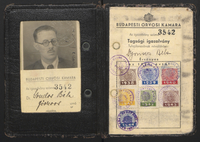
Bela Gondos family papers
Document
The Bela Gondos family papers consist of biographical materials, refugee and emigration papers, and writings documenting Bela, Anna, and Judith Gondos of Budapest and their journey aboard the rescue train organized by Rezső Kasztner, internment at Bergen-Belsen, transfer to Switzerland, and immigration to the United States. Biographical materials include birth and marriage certificates, identification papers, citizenship documents, education and professional records, foreign worker and air raid worker certificates, and inoculation records documenting Bela, Anna, and Judith Gondos and Bela’s training and career as a physician. This series also includes an authorization signed by Dr. Polgar in Bergen-Belsen allowing Bela Gondos to receive wood for shoe soles. Photographs depict the Gondos family, their friends, and Anna Gondos’ parents, Jakab and Iren Havas. Refugee and emigration papers include attestations and travel papers documenting the Gondos family’s status as refugees in Switzerland and their departure via Genoa for the United States. Writings consists of lectures presented by Bela Gondos to the Ohr Kodesh Congregation in Chevy Chase, Maryland, between 1989 and 1995 on topics including the Holocaust and Jewish communities in Hungary, the Kasztner train, and Jewish passivity, organization, or resistance in the face of the Holocaust.
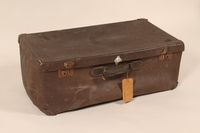
Large brown suitcase used by Hungarian Jewish refugees on the Kasztner train
Object
Large suitcase carried by Dr. Bela Gondos when he was transported from Budapest, Hungary, to Bergen-Belsen concentration camp on the Kasztner train in June 1944 with his wife Anna and 7 year old daughter Judit. They were advised to bring all their belongings. Each carried a suitcase filled with their best clothing since they believed they were going to Portugal. They used it as a bed, table, and chair on the cattle car to the camp. Jews were increasingly persecuted by the Hungarian regime, which had anti-Semitic policies similar to Germany's. Bela worked on 2 or 3 forced labor battalions until released in 1942 because he was a physician. On March 19, 1944, Germany invaded Hungary and the authorities prepared to deport all the Jews from Hungary to concentration camps. In mid-May, Bela heard about the Kasztner train, negotiated by Rezso Kasztner of the Relief and Rescue Committee of the Hungarian Zionist Association to get the German SS to take money to release Jews to neutral territory. Bela and his family were selected because of Bela’s Zionist ties. Kasztner failed to raise sufficient funds and the train was sent to Bergen-Belsen, arriving at the camp on July 8. After ransom money was raised by Jewish aid organizations, the prisoners were sent from Bergen-Belsen to Switzerland on December 7, 1944. Bela, Anna, and Judit emigrated to the United States in 1946.
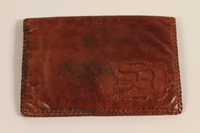
FK monogrammed leather document case made by a Jewish Hungarian woman
Object
Leather document case with wallet pockets made by Anna Gondos in the early 1940’s when she had to support herself and her daughter Judit, age 7, while her husband Bela was away in the Hungarian forced labor service. She carried it when she was deported from Budapest to Bergen-Belsen on the Kasztner train with Bela and Judit in June 1944. The FK monogram suggests that the wallet was made for someone but was never purchased. Jews were increasingly persecuted by the Nazi-influenced Hungarian regime. Bela worked in 2 or 3 forced labor battalions until released in 1942 because he was a physician. On March 19, 1944, Germany invaded Hungary and the authorities prepared to deport all the Jews from Hungary to concentration camps. In mid-May, Bela heard about the Kasztner train, negotiated by Rezso Kasztner of the Zionist Relief and Rescue Committee to get the German SS to take money to release Jews to neutral territory. Bela and his family were selected because of Bela’s Zionist ties. Kasztner failed to raise sufficient funds and the train was sent to Bergen-Belsen, arriving on July 8. After ransom money was raised by Jewish aid organizations, the prisoners were sent to Switzerland on December 7, 1944. Bela, Anna, and Judit emigrated to the United States in 1946.
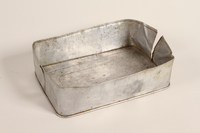
Aluminum food container lid used by a Hungarian Jewish family on the Kasztner train
Object
Metal food container lid used by Bela, Anna, and Judit Gondos when they were transported from Budapest, Hungary, to Bergen-Belsen concentration camp on the Kasztner train in June 1944. The family often hiked at Svabhegy, a hill outside Budapest, and used the container with the now missing base for their picnics. Jews were increasingly persecuted by the Nazi-influenced Hungarian regime. Bela worked on 2 or 3 forced labor battalions until released in 1942 because he was a physician. On March 19, 1944, Germany invaded Hungary and the authorities prepared to deport all the Jews from Hungary to concentration camps. In mid-May, Bela heard about the Kasztner train, negotiated by Rezso Kasztner of the Relief and Rescue Committee, Hungarian Zionist Association, to get the German SS to take money to release Jews to neutral territory. Bela and his family were selected because of Bela’s Zionist ties. Kasztner failed to raise sufficient funds and the train was sent to Bergen-Belsen, arriving on July 8. After ransom money was raised by Jewish aid organizations, the prisoners were sent from Bergen-Belsen on December 7, 1944. Bela, Anna, and Judit emigrated to the United States in 1946.
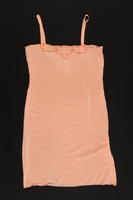
Peach chemise with floral embroidery saved by a Hungarian Jewish refugee
Object
Embroidered silk chemise custom made for Anna Havas for her 1934 wedding to Bela Gondos. She took it with her when she was deported from Budapest, Hungary, to Bergen-Belsen on the Kasztner train with Bela and their 7 year old daughter Judit in June 1944. The family brought their best clothing since they believed they were going to Portugal. Jews were increasingly persecuted by the Nazi-influenced Hungarian regime. Bela worked on 2 or 3 forced labor battalions until released in 1942 because he was a physician. On March 19, 1944, Germany invaded Hungary and the authorities prepared to deport all the Jews from Hungary to concentration camps. In mid-May, Bela heard about the Kasztner train, negotiated by Rezso Kasztner of the Relief and Rescue Committee, Hungarian Zionist Association, to get the German SS to take money to release Jews to neutral territory. Bela and his family were selected because of Bela’s Zionist ties. Kasztner failed to raise sufficient funds and the train was sent to Bergen-Belsen, arriving on July 8. After ransom money was raised by Jewish aid organizations, the prisoners were sent to Switzerland on December 7, 1944. Bela, Anna, and Judit emigrated to the United States in 1946.
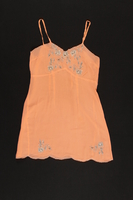
Peach chemise with black and white floral appliques saved by a Hungarian Jewish refugee
Object
Silk chemise with embroidered floral appliques custom made for Anna Havas for her 1934 wedding to Bela Gondos. She took it with her when she was deported from Budapest, Hungary, to Bergen-Belsen on the Kasztner train with Bela and their 7 year old daughter Judit in June 1944. The family brought their best clothing since they believed they were going to Portugal. Jews were increasingly persecuted by the Nazi-influenced Hungarian regime. Bela worked on 2 or 3 forced labor battalions until released in 1942 because he was a physician. On March 19, 1944, Germany invaded Hungary and the authorities prepared to deport all the Jews from Hungary to concentration camps. In mid-May, Bela heard about the Kasztner train, negotiated by Rezso Kasztner of the Relief and Rescue Committee, Hungarian Zionist Association, to get the German SS to take money to release Jews to neutral territory. Bela and his family were selected because of Bela’s Zionist ties. Kasztner failed to raise sufficient funds and the train was sent to Bergen-Belsen, arriving on July 8. After ransom money was raised by Jewish aid organizations, the prisoners were sent to Switzerland on December 7, 1944. Bela, Anna, and Judit emigrated to the United States in 1946.
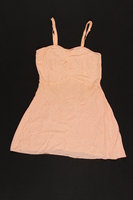
Peach floral printed chemise saved by a Hungarian Jewish refugee
Object
Floral printed silk slip custom made for Anna Havas Gondos and taken with her when she was deported from Budapest, Hungary to Bergen-Belsen on the Kasztner train with her husband Bela and 7 year old daughter Judit in June 1944. The family brought their best clothing since they believed they were going to Portugal. Jews were increasingly persecuted by the Nazi-influenced Hungarian regime. Bela worked on 2 or 3 forced labor battalions until released in 1942 because he was a physician. On March 19, 1944, Germany invaded Hungary and the authorities prepared to deport all the Jews from Hungary to concentration camps. In mid-May, Bela heard about the Kasztner train, negotiated by Rezso Kasztner of the Relief and Rescue Committee, Hungarian Zionist Association, to get the German SS to take money to release Jews to neutral territory. Bela and his family were selected because of Bela’s Zionist ties. Kasztner failed to raise sufficient funds and the train was sent to Bergen-Belsen, arriving on July 8. After ransom money was raised by Jewish aid organizations, the prisoners were sent to Switzerland on December 7, 1944. Bela, Anna, and Judit emigrated to the United States in 1946.
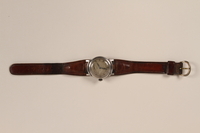
Omega wristwatch worn by a Hungarian Jewish man on the Kasztner train
Object
Omega steel wristwatch worn by Dr. Bela Gondos when he was deported from Budapest, Hungary to Bergen-Belsen on the Kasztner train with his wife Anna and 7 year old daughter Judit in June 1944. He purchased the watch in 1940 or 1941 and it was not confiscated by the Germans because it was made of steel, not gold. Jews were increasingly persecuted by the Nazi-influenced Hungarian regime. Bela worked on 2 or 3 forced labor battalions until released in 1942 because he was a physician. On March 19, 1944, Germany invaded Hungary and the authorities prepared to deport all the Jews from Hungary to concentration camps. In mid-May, Bela heard about the Kasztner train, negotiated by Rezso Kasztner of the Relief and Rescue Committee, Hungarian Zionist Association, to get the German SS to take money to release Jews to neutral territory. Bela and his family were selected because of Bela’s Zionist ties. Kasztner failed to raise sufficient funds and the train was sent to Bergen-Belsen, arriving on July 8. After ransom money was raised by Jewish aid organizations, the prisoners were sent to Switzerland on December 7, 1944. Bela, Anna, and Judit emigrated to the United States in 1946.
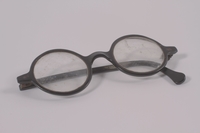
Black Bakelite circular eyeglasses worn by a Hungarian Jewish man on the Kasztner train
Object
Black Bakelite spectacles worn by Dr. Bela Gondos when he was deported from Budapest, Hungary to Bergen-Belsen on the Kasztner train with his wife Anna and 7 year old daughter Judit in June 1944. Jews were increasingly persecuted by the Nazi-influenced Hungarian regime. Bela worked on 2 or 3 forced labor battalions until released in 1942 because he was a physician. On March 19, 1944, Germany invaded Hungary and the authorities prepared to deport all the Jews from Hungary to concentration camps. In mid-May, Bela heard about the Kasztner train, negotiated by Rezso Kasztner of the Relief and Rescue Committee, Hungarian Zionist Association, to get the German SS to take money to release Jews to neutral territory. Bela and his family were selected because of Bela’s Zionist ties. Kasztner failed to raise sufficient funds and the train was sent to Bergen-Belsen, arriving on July 8. After ransom money was raised by Jewish aid organizations, the prisoners were sent to Switzerland on December 7, 1944. Bela, Anna, and Judit emigrated to the United States in 1946.
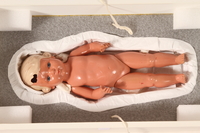
Plastic doll named Zsuzsi carried by a young Hungarian Jewish girl on the Kasztner train
Object
Celluloid Schildkrot doll named Zsuzsi carried by 7 year old Judit Gondos when she left Budapest with her parents Bela and Anna on the Kasztner train in June 1944. Judit received the doll from her parents for Chanukah in 1942. After arguments and many tears, she was allowed to take the doll on the train if she carried it herself. The doll’s dress was lost long ago. Jews were increasingly persecuted by the Nazi-influenced Hungarian regime. Bela worked on 2 or 3 forced labor battalions until released in 1942 because he was a physician. On March 19, 1944, Germany invaded Hungary and the authorities prepared to deport all the Jews from Hungary to concentration camps. In mid-May, Bela heard about the Kasztner train, negotiated by Rezso Kasztner of the Relief and Rescue Committee, Hungarian Zionist Association, to get the German SS to take money to release Jews to neutral territory. Bela and his family were selected because of Bela’s Zionist ties. Kasztner failed to raise sufficient funds and the train was sent to Bergen-Belsen, arriving on July 8. After ransom money was raised by Jewish aid organizations, the prisoners were sent to Switzerland on December 7, 1944. Bela, Anna, and Judit emigrated to the United States in 1946.
Satirical drawing of his prescription made by a camp inmate for his doctor, a fellow inmate
Object
Elegant cartoon in pencil and watercolor done by Istvan Irsai and given to Dr. Bela Gondos in Bergen-Belsen concentration camp on October 17, 1944, as an expression of gratitude. It depicts an oversize thermometer stuck into a piece of bread, Dr. Gondos's prescription for his starving patient, whom he saw weekly. Both men were inmates arrived in the camp on the Kastzner rescue transport from Budapest, on July 8, 1944. Bela diagnosed Istvan with starvation and the prescribed extra portion of bread was filled by the informal organization of the Hungarian camp. Bela's wife Anna and 7 year old daughter Judit were also in the camp. The Kastzner train was arranged by Reszo Kastzner who persuaded the German SS to accept money to allow a trainful of Jews to leave Budapest. The intent was to send them to Palestine or Portugal, but not enough money was raised, so they were sent to Bergen-Belsen. The Gondos family and Istvan were sent to Zurich, Switzerland, in December 1944, after a Jewish organization raised ransom money. Istvan left for Palestine in 1945. The Gondos family emigrated to America in fall 1946.



